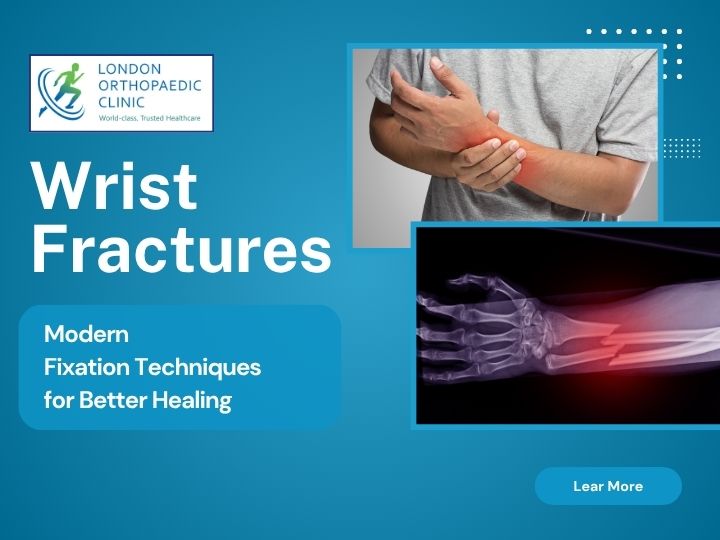
Common types of wrist surgeries. Wrist pain can disrupt everyday life — from writing and typing to lifting a cup of tea. When conservative treatments like physiotherapy, rest, or medication fail, wrist surgery might be the only way to regain mobility and reduce pain. At London Orthopaedic Clinic, Nagpur, under the expert guidance of Dr. Vishal Sahni, patients receive world-class treatment for all types of wrist conditions.
In this comprehensive guide, we explain the common types of wrist surgeries, when they are needed, what to expect before and after surgery, and how to choose the right orthopedic doctor in Nagpur.

Complete Guide by Dr. Vishal Sahni
About Dr. Vishal Sahni
Dr. Vishal Sahni is a senior Orthopedic Surgeon and Shoulder Specialist in Nagpur, with over 24 years of experience in the UK and India. As the Director of London Orthopaedic Clinic, Dhantoli, he specialises in advanced wrist, shoulder, and upper limb surgeries using minimally invasive techniques and personalised care protocols.
Why Wrist Surgery Might Be Necessary
Wrist surgeries are generally performed when non-surgical treatments no longer provide relief. Common wrist problems include:
- Wrist fractures
- Carpal tunnel syndrome
- Ligament injuries
- Ganglion cysts
- Arthritis of the wrist
- Kienböck’s disease
- Tendonitis
When pain, stiffness, or instability in the wrist limits daily activities, it may be time to consult an Orthopedic Doctor in Nagpur.
Common Types of Wrist Surgeries
Let’s explore the most common wrist surgeries offered at London Orthopaedic Clinic, Nagpur, with detailed explanations.
1. Wrist Arthroscopy
What is it?
Wrist arthroscopy is a minimally invasive surgical procedure that uses a small camera (arthroscope) to look inside the wrist joint.
Purpose:
- Diagnosing ligament tears
- Treating cartilage damage
- Removing loose bone or tissue
- Washing out inflamed areas
Advantages:
- Smaller incisions
- Faster recovery
- Minimal scarring
Who needs it?
Patients with wrist pain, swelling, or suspected ligament injury often benefit from this advanced technique.
2. Carpal Tunnel Release Surgery
What is it?
This surgery relieves pressure on the median nerve, which passes through the carpal tunnel in your wrist.
Symptoms that indicate need:
- Numbness or tingling in the thumb, index, and middle fingers
- Weak grip
- Nighttime wrist pain
Surgical Technique:
Dr. Vishal Sahni performs both open and endoscopic carpal tunnel release depending on the patient’s condition.
Recovery Time:
Patients often return to normal activity within 2 to 6 weeks.
3. Wrist Fracture Fixation
What is it?
If your wrist is broken (commonly the distal radius), surgical fixation may be required to align the bones properly.
Treatment Options:
- Plates and screws (open reduction and internal fixation – ORIF)
- External fixation
- K-wires
When is it needed?
Severe fractures, misaligned bones, or cases not healing with plaster require surgical intervention.
4. Ganglion Cyst Removal
What is it?
Ganglion cysts are non-cancerous fluid-filled lumps that appear on the wrist. When painful or recurring, surgery is done to remove them.
Procedure:
Dr. Sahni performs a small incision and carefully removes the cyst along with its root to prevent recurrence.
Recovery Time:
Most patients recover fully within 2 to 4 weeks.
5. Wrist Ligament Repair or Reconstruction
What is it?
Wrist ligaments provide stability. When torn or damaged, surgery is needed to restore function.
Common injuries:
- Scapholunate ligament tear
- TFCC (Triangular Fibrocartilage Complex) tear
Surgical Methods:
- Arthroscopic debridement
- Open repair with tendon grafts
- Internal bracing
Recovery:
Complete healing may take 6–12 weeks, followed by rehabilitation.
6. Wrist Joint Fusion (Arthrodesis)
What is it?
This surgery fuses bones in the wrist to form a single solid bone, typically done when pain relief is the priority over wrist movement.
Indicated in:
- Severe arthritis
- Non-repairable fractures
- Chronic instability
Types:
- Partial wrist fusion
- Total wrist fusion
Outcome:
Pain relief is significant, although range of motion is reduced.
7. Wrist Joint Replacement (Arthroplasty)
What is it?
Wrist joint replacement is a surgical procedure where the damaged wrist joint is replaced with an artificial implant.
Who benefits?
Patients with:
- End-stage arthritis
- Rheumatoid arthritis
- Degenerative joint disease
Benefits:
- Pain relief
- Improved mobility
- Better function than fusion in selected cases
Dr. Vishal Sahni performs this surgery with precision to maximise outcomes for patients with chronic wrist conditions.
8. TFCC Surgery (Triangular Fibrocartilage Complex Repair)
What is TFCC?
It’s a cartilage structure that stabilises the wrist’s small bones. TFCC injuries cause pain on the ulnar (little finger) side of the wrist.
Surgical Treatment:
- Arthroscopic repair
- Debridement (cleaning damaged tissue)
Post-op Care:
A wrist brace or cast may be needed for several weeks, followed by strengthening exercises.
Wrist Surgery: What to Expect
Before Surgery:
- Diagnosis via X-ray, MRI, or CT scan
- Consultation with a shoulder and wrist specialist in Nagpur
- Blood tests and fitness evaluation
During Surgery:
- Performed under local, regional, or general anaesthesia
- May be minimally invasive or open procedure
After Surgery:
- Pain management
- Physiotherapy for recovery
- Return to work in 2–8 weeks depending on the procedure
Why Choose London Orthopaedic Clinic, Nagpur?
- Experienced Surgeon: Dr. Vishal Sahni has trained and practised in the UK for over 20 years
- Advanced Facilities: Minimally invasive surgical tools and state-of-the-art operation theatres
- Patient-Centred Care: Every treatment plan is tailored to the patient’s condition and lifestyle
- High Success Rate: Hundreds of satisfied patients across Nagpur and Maharashtra
FAQs on Wrist Surgery – Expert Answers by Dr. Vishal Sahni
1. What are the most common wrist surgeries?
Wrist arthroscopy, carpal tunnel release, ligament repair, ganglion cyst removal, fracture fixation, and wrist joint replacement are the most common.
2. Is wrist surgery painful?
Mild discomfort may occur post-surgery, but pain is well-managed with medications and most patients recover comfortably.
3. How long is the recovery period?
Recovery varies. Simple arthroscopy may take 2 weeks, while complex fusion or replacement can take 6–12 weeks.
4. When should I consider wrist surgery?
If pain, weakness, or instability continues despite physiotherapy and medication, surgery may be necessary.
5. What is the success rate of wrist surgeries?
With advanced techniques, success rates are over 90% at London Orthopaedic Clinic, Nagpur.
6. Can I avoid wrist surgery?
Mild conditions can be treated non-surgically, but delaying surgery for major problems can worsen outcomes.
7. What is wrist arthroscopy used for?
It helps diagnose and treat joint inflammation, ligament tears, and cartilage damage using a small camera.
8. What is carpal tunnel release?
This surgery removes pressure on the median nerve by cutting the tight ligament causing compression.
9. Will I have a scar after wrist surgery?
Minimally invasive surgeries leave minimal scarring, while open surgeries may leave a small line.
10. Can wrist surgery fix arthritis?
Yes, joint replacement or fusion can relieve arthritis pain and improve hand function.
11. Is physiotherapy needed after surgery?
Absolutely. Rehabilitation ensures full recovery, restores strength, and improves flexibility.
12. Can wrist fractures heal without surgery?
Minor fractures may heal with splints or casts, but displaced or severe ones require surgical fixation.
13. What are ganglion cysts?
They are fluid-filled lumps that form near joints or tendons and may need removal if painful or recurrent.
14. Is wrist joint replacement safe?
Yes. It is a proven method for relieving chronic wrist pain, especially due to arthritis.
15. How soon can I return to work?
It depends on the type of surgery. Light-duty work may resume in 2–4 weeks, while manual work may take longer.
16. Is wrist ligament surgery successful?
Yes, especially with early diagnosis. Repair or reconstruction restores stability and function.
17. What is wrist fusion?
A surgical method that eliminates painful movement by joining bones permanently, commonly used in severe arthritis.
18. Are there risks involved?
All surgeries carry risks like infection or stiffness, but these are rare when performed by skilled hands.
19. How do I prepare for wrist surgery?
Avoid smoking, follow your doctor’s instructions, and ensure someone accompanies you on the day of surgery.
20. Who is the best orthopedic surgeon for wrist surgery in Nagpur?
Dr. Vishal Sahni is a highly trusted name in Nagpur for wrist and upper limb surgeries with international training and decades of experience.
📍 London Orthopaedic Clinic
Dhantoli, Nagpur, Maharashtra
👨⚕️ Dr. Vishal Sahni – Shoulder & Wrist Specialist
📞 Call: +91 95295 52938
🌐 Visit: www.londonorthopaedicclinicngp.com
-

Winter Shoulder Pain: Why It Gets Worse & How to Manage It
-

Wrist Fractures: Modern Fixation Techniques for Better Healing
-

PRP & Stem Cell Therapy for Shoulder Injuries: Does It Really Work?
-

How Robotic-Assisted Shoulder Surgery is Changing Recovery in 2025